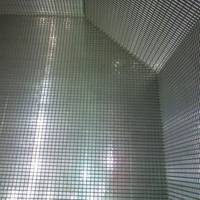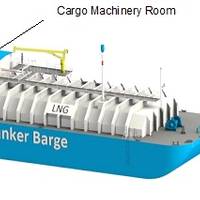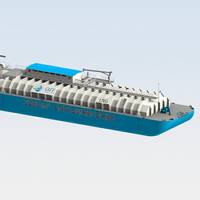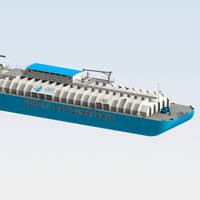Solving the LNG Propulsion Puzzle

The last piece of the LNG infrastructure puzzle, in the form of North America’s first LNG bunker barge, falls into place at Conrad’s Orange, Texas Shipyard. With continued debate over new emissions standards and compliance dates hanging over the heads of operators in the Emission Compliance Zones like the Sword of Damocles, WesPac Midstream LLC, a provider of liquefied natural gas solutions, and its affiliate Clean Marine Energy, a facilitator of solutions for emission compliance…
Powering Ahead with a Clean Design
The Shearer Group and Conrad Shipyard collaborate on an ABS approved LNG Towboat Design. What happens next could change inland shipping forever. The December announcement that Conrad Shipyard, L.L.C. and The Shearer Group, Inc. (TSGI) had worked together to develop the design of a Liquefied Natural Gas (LNG) powered 4,200 horsepower towboat utilizing a proven TSGI design was, perhaps, exciting enough on its own merits. That the team had also been awarded an “Approval in Principle” (AIP) by the American Bureau of Shipping (ABS) for the design was especially significant for the nation’s inland waterfront. Packing clean LNG power into an inland towboat was no easy task. And yet, the potential for the concept to blossom in this largely fixed, point-to-point market is very real.
DNV GL Approves GTT Membrane LNG Bunker Barge

Houston-based GTT North America (GTT NA), U.S. subsidiary of French engineering and technology company GTT (Gaztransport & Technigaz SA), has received an Approval in Principle from DNV GL for the design of a 2,200 cubic meter liquefied natural gas (LNG) bunker barge. The distinctive design incorporates GTT’s proven membrane Cargo Containment System (CCS), which is utilized in roughly 70% of the global LNG carrier fleet and nearly 90% of LNG carrier projects on order. “This Approval in Principle from DNV GL…
ABS Approves Design for GTTNA’s LNG Bunker Barge

GTT North America (GTTNA), the Houston-based subsidiary of French engineering and technology company Gaztransport & Technigaz SA (GTT), received approval in principle from ABS for the design of a 2,200 cu.m. liquefied natural gas (LNG) bunker barge. The design incorporates GTT’s membrane Cargo Containment System (CCS), which is used in 70% of the global LNG carrier fleet and nearly 90% of LNG carrier projects on order. GTT developed the membrane LNG bunker barge to demonstrate the efficient storage of LNG and safe…
ABS Approves GTTNA’s LNG Bunker Barge Design

Houston-based GTT North America (GTTNA), U.S. subsidiary of French engineering and technology company Gaztransport & Technigaz SA (GTT), has received approval in principle (AIP) from ABS for the design of a 2,200 cubic meter liquefied natural gas (LNG) bunker barge. The distinctive design incorporates GTT’s proven membrane Cargo Containment System (CCS), which is utilized in 70% of the global LNG carrier fleet and nearly 90% of LNG carrier projects on order. Leveraging over five decades of LNG storage and maritime transportation experience…
LNG Containment System Upgrade DNV Qualified
GTT’s Mark III LNG cargo containment system reduces the boil-off rate from LNG carriers by one third. Mark III is GTT’s well-established containment system. This has now been further developed to reduce the boil-off rate from 0.15% to 0.10% of the cargo volume per day. The common industry practice has been to build LNG carriers with boil-off rates of 0.15% of the cargo volume per day, reflecting the typical need for boil-off gas as fuel on board. The Mark III Flex system has been developed in response to the reduced need for fuel gas due to the improved efficiency and changed operational practice of LNG carriers. For current standard LNG carrier designs with a cargo capacity in the range of 160…





